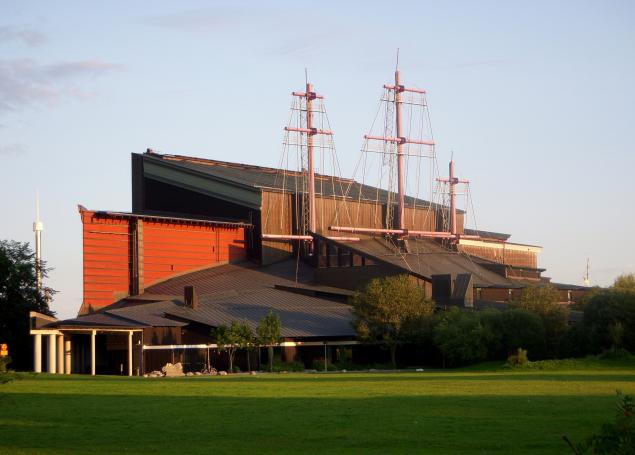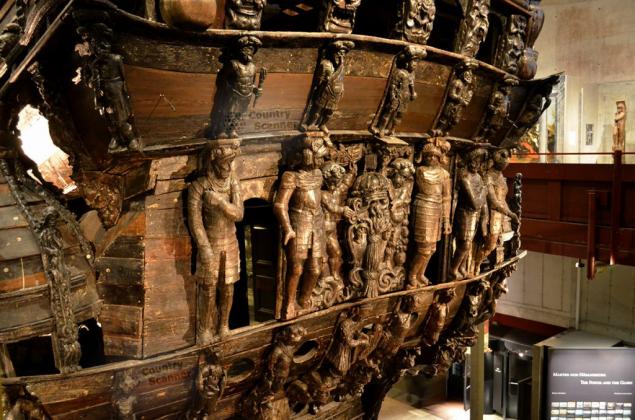MUSEUM WARSHIP IN STOCKHOLM
 Bashny.Net
Bashny.Net
Seventy million one hundred fifty four thousand seven hundred sixty one
The Vasa Museum opened in 1990 to show the Vasa, an impressive warship that sank into the deep waters on its maiden voyage in 1628. The ship was restored in the early 1960-ies and is now one of the most popular attractions of Stockholm.

In 1625 king Gustav II Adolf, member of the dynasty of Vasa, was commissioned to build four new warships, of which the Vasa has become the most important.
It was the largest ship ever built in Sweden, and the Vasa was to be the proud naval shipbuilding. The construction of the Galleon began at the naval dockyard, now a district of Blasieholmen. The work on the construction of the ship was involved in at least three hundred people, a ship built in a fairly short period of time, it took less than three years.

Accident Васа10 Aug 1628 near the piers was a big crowd, to see how Vasa departs from Slussen to your first flight. The ship headed to sea base Alvsnabben where on Board should rise about three hundred soldiers. But the cruiser did not reach its destination: shortly after he picked up four of its ten sails, the ship began to penetrate the water through the open gun hatches. The voyage was short, and the journey ended sadly – now just 1300 meters (0.8 miles), the ship sank, taking down with her a total of one hundred and fifty people.
After the disaster the captain of the ship was taken into custody, but it soon became clear that the main cause of the accident wasn't his fault. The ship, although he was well built for years verified the methodology traditionally used by the Dutch masters, was not proportional. The ship was too heavy and high for your body.
The Salvation Of The Vasa
Already in the seventeenth century, attempts were made to save the ship, but was recovered only guns. Over time, the exact position of the disaster are gone.
Finally, in 1956, after several years of searching for the site of the shipwreck, it was determined by the Amateur archaeologist Anders Franzen. He established a place of flooding was found in the wooden chip case. In the following year, was held technically complex preparatory work for the lifting of the sailboat. After several years of preliminary work, Vasa returned to the surface in 1961.
Due to the low salt levels in the water wooden ship was well preserved because ship worms survive only in water with minimal salt. However, still had a huge renovation work, which had restored thousands of items.
The Vasa Museum
It was clear that such an impressive part of the story deserves its own Museum. Shortly after the Vasa was salvaged, the shipyard was opened in the Vasa Museum. In 1987 Djurgarden began the construction of a purpose-built Museum for the Vasa, close to where the ship sank in 1628. Three years later, the Vasa Museum opened to the public.
The exterior of the building, designed by Goran Manson, and Marianne with Albacom, was clearly inspired by the shape of a giant sailing ship. The Vasa was the largest warship of its time: it had 10 sails, carried 64 cannons, had a crew of 145 people and could accommodate 300 soldiers. The ship had a length of about 69 meters (226 ft) and its main mast was more than 52 meters. But what makes the ship really impressive is the rich decoration. Military sailing ship was specially created and imported from Holland, Germany and Italy, 500 sculptures and 200 other decorations.

The most impressive decorations are the big lion on the ship and feed the majestic height of 19.3 meters (63 ft) which is fully covered with beautiful sculptures. Lion is a hint of king Gustav II, who was known as "the lion of the North".
Most of the statues on the ship depict figures from Greek mythology and the Bible. But there are also images of the sea monsters that Swedish aristocrats and Royal symbols. The original sculptures are now in plain wood, but originally they were painted in bright colors. A fully painted scale model of the Vasa shows how the ship was supposed to look in 1628.
The Vasa Museum opened in 1990 to show the Vasa, an impressive warship that sank into the deep waters on its maiden voyage in 1628. The ship was restored in the early 1960-ies and is now one of the most popular attractions of Stockholm.

In 1625 king Gustav II Adolf, member of the dynasty of Vasa, was commissioned to build four new warships, of which the Vasa has become the most important.
It was the largest ship ever built in Sweden, and the Vasa was to be the proud naval shipbuilding. The construction of the Galleon began at the naval dockyard, now a district of Blasieholmen. The work on the construction of the ship was involved in at least three hundred people, a ship built in a fairly short period of time, it took less than three years.

Accident Васа10 Aug 1628 near the piers was a big crowd, to see how Vasa departs from Slussen to your first flight. The ship headed to sea base Alvsnabben where on Board should rise about three hundred soldiers. But the cruiser did not reach its destination: shortly after he picked up four of its ten sails, the ship began to penetrate the water through the open gun hatches. The voyage was short, and the journey ended sadly – now just 1300 meters (0.8 miles), the ship sank, taking down with her a total of one hundred and fifty people.
After the disaster the captain of the ship was taken into custody, but it soon became clear that the main cause of the accident wasn't his fault. The ship, although he was well built for years verified the methodology traditionally used by the Dutch masters, was not proportional. The ship was too heavy and high for your body.
The Salvation Of The Vasa
Already in the seventeenth century, attempts were made to save the ship, but was recovered only guns. Over time, the exact position of the disaster are gone.
Finally, in 1956, after several years of searching for the site of the shipwreck, it was determined by the Amateur archaeologist Anders Franzen. He established a place of flooding was found in the wooden chip case. In the following year, was held technically complex preparatory work for the lifting of the sailboat. After several years of preliminary work, Vasa returned to the surface in 1961.
Due to the low salt levels in the water wooden ship was well preserved because ship worms survive only in water with minimal salt. However, still had a huge renovation work, which had restored thousands of items.
The Vasa Museum
It was clear that such an impressive part of the story deserves its own Museum. Shortly after the Vasa was salvaged, the shipyard was opened in the Vasa Museum. In 1987 Djurgarden began the construction of a purpose-built Museum for the Vasa, close to where the ship sank in 1628. Three years later, the Vasa Museum opened to the public.
The exterior of the building, designed by Goran Manson, and Marianne with Albacom, was clearly inspired by the shape of a giant sailing ship. The Vasa was the largest warship of its time: it had 10 sails, carried 64 cannons, had a crew of 145 people and could accommodate 300 soldiers. The ship had a length of about 69 meters (226 ft) and its main mast was more than 52 meters. But what makes the ship really impressive is the rich decoration. Military sailing ship was specially created and imported from Holland, Germany and Italy, 500 sculptures and 200 other decorations.

The most impressive decorations are the big lion on the ship and feed the majestic height of 19.3 meters (63 ft) which is fully covered with beautiful sculptures. Lion is a hint of king Gustav II, who was known as "the lion of the North".
Most of the statues on the ship depict figures from Greek mythology and the Bible. But there are also images of the sea monsters that Swedish aristocrats and Royal symbols. The original sculptures are now in plain wood, but originally they were painted in bright colors. A fully painted scale model of the Vasa shows how the ship was supposed to look in 1628.
Tags
See also
Museum of military vehicles in Ryazan
Pictures of military equipment, which stood in the Ice Palace in anticipation of the start of the rehearsal of the Victory Parade
Prisoners at the Domodedovo airport
g.Semёnov. Trim on the windows (82 photos)
Man has bought hundreds of tickets for "Transformers" to show the ex-girlfriend, how he became a rich man
Six extravagant methods of power from the depths of the oceans
Kimberly Brownlie: self-sufficient person is a cultural myth, divorced from real life
Me and Orson Welles (Me and Orson Welles)
How to meet a girl

















